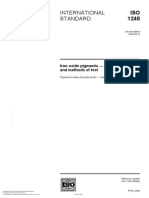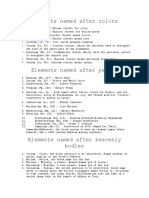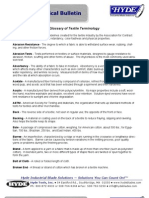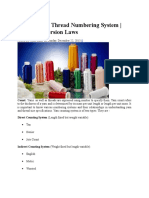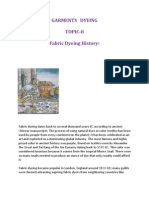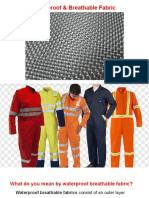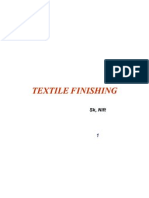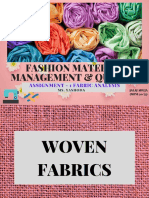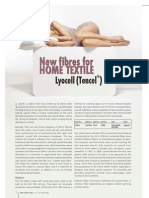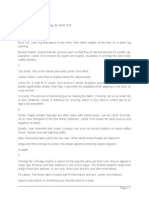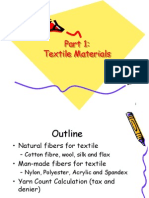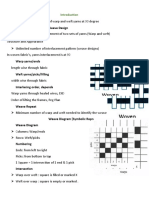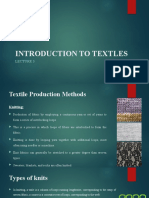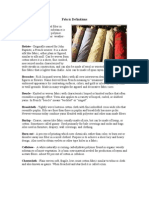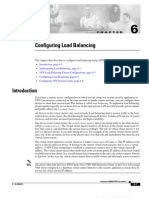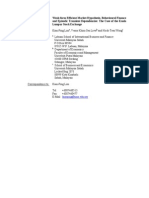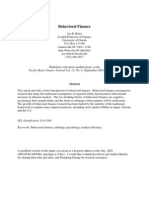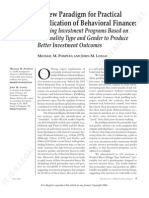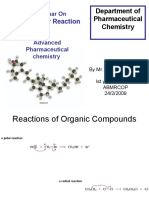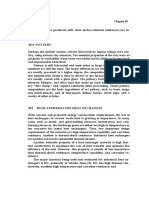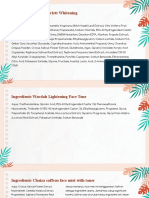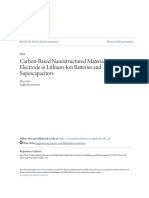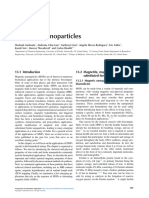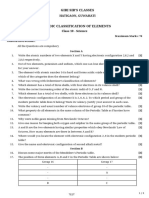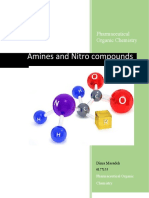Fabric Terminology
Fabric Terminology
Uploaded by
Abey FrancisCopyright:
Available Formats
Fabric Terminology
Fabric Terminology
Uploaded by
Abey FrancisOriginal Description:
Copyright
Available Formats
Share this document
Did you find this document useful?
Is this content inappropriate?
Copyright:
Available Formats
Fabric Terminology
Fabric Terminology
Uploaded by
Abey FrancisCopyright:
Available Formats
FABRIC TERMINOLOGY
Absorbency - The ability of a fabric to take in moisture. Absorbency is a very important property, which effects many other characteristics such as skin comfort, static build-up, shrinkage, stain removal, water repellency, and wrinkle recovery. Acetate - A manufactured fiber formed by compound of cellulose, refined from cotton linters and/or wood pulp, and acedic acid that has been extruded through a spinneret and then hardened. Acrylic - A manufactured fiber derived from polyacrylonitrile. Its major properties include a soft, wool-like hand, machine washable and dryable, excellent color retention. Solution-dyed versions have excellent resistance to sunlight and chlorine degradation. Antique Satin A heavy, dull faced satin, often used for draperies. Alpaca - A natural hair fiber obtained from the Alpaca sheep, a domesticated member of the llama family. The fiber is most commonly used in fabrics made into dresses, suits, coats, and sweaters. Angora - The hair of the Angora goat. Also known as Angora mohair. Angora may also apply to the fur of the Angora rabbit. However, according to the U.S. Federal Trade Commission, any apparel containing Angora rabbit hair must be labeled as "Angora rabbit hair" on the garment. Bainin Handwoven woolen homespun fabric from Ireland. Barr - An imperfection, characterized by a ridge or mark running in the crosswise or lengthwise directions of the fabric. Barrs can be caused by tension variations in the knitting process, poor quality yarns, problems during the finishing process. Basket Weave - A variation of the plain weave construction, formed by treating two or more warp yarns and/or two or more filling yarns as one unit in the weaving process. Yarns in a basket weave are laid into the woven construction flat, and maintain a parallel relationship. Both balanced and unbalanced basket weave fabrics can be produced. Examples of basket weave construction includes monk cloth and oxford cloth. Bast Fiber - Strong, soft, woody fibers, such as flax, jute, hemp, and ramie, which are obtained from the inner bark in the stems of certain plants. Batik - A method of dying originating in Java. Parts of the cloth are covered with wax, leaving the uncoated parts to take the dye. Batiste - A medium-weight, plain weave fabric, usually made of cotton or cotton blends. Enduses include blouses and dresses. Bedford Cord - A cord cotton-like fabric with raised ridges in the lengthwise direction. Since the fabric has a high strength and a high durability, it is often used for upholstery and work clothes. Blend - A term applied to a yarn or a fabric that is made up of more than one fiber. In blended yarns, two or more different types of staple fibers are twisted or spun together to form the yarn. Examples of a typical blended yarn or fabric is polyester/cotton.
Boucle - A knit or woven fabric made from a rough, curly, knotted boucle yarn. The fabric has a looped, knotted surface and is often used in sportswear and coats. Broadcloth - A plain weave tightly woven fabric, characterized by a slight ridge effect in one direction, usually the filling. The most common broadcloth is made from cotton or cotton/polyester blends. Brocade - A heavy, exquisite jacquard type fabric with an all-over raised pattern or floral design. Common end-uses include such formal applications as upholstery, draperies, and eveningwear. Brocatelle - A heavy cross ribbed jacquard woven fabric used for furnishing and draperies. It has raised figures or designs more pronounced than in brocade. Burlap - A loosely constructed, heavy weight, plain weave fabric used as a carpet backing, and as inexpensive packaging for sacks of grain or rice. Also, as fashion dictates, burlap may also appear as a drapery fabric. Burn-out - A brocade-like pattern effect created on the fabric through the application of a chemical, instead of color, during the burn-out printing process. (Sulfuric acid, mixed into a colorless print paste, is the most common chemical used.) Many simulated eyelet effects can be created using this method. In these instances, the chemical destroys the fiber and creates a hole in the fabric in a specific design, where the chemical comes in contact with the fabric. The fabric is then over-printed with a simulated embroidery stitch to create the eyelet effect. However, burnout effects can also be created on velvets made of blended fibers, in which the ground fabric is of one fiber like a polyester, and the pile may be of a cellulosic fiber like rayon or acetate. In this case, when the chemical is printed in a certain pattern, it destroys the pile in those areas where the chemical comes in contact with the fabric, but leave the ground fabric unharmed. Calendering - A process for finishing fabrics in which such special effects as high luster, glazing, embossing, and moir are produced. Calico - A tightly-woven cotton type fabric with an all-over print, usually a small floral pattern on a contrasting background color. Common end-uses include dresses, aprons, and quilts. Camel's Hair - A natural fiber obtained from the hair of the Bactrian camel, a two-humped pack-carrying species. The fiber is used primarily in coats, sweaters, and suits. Canvas A heavy, strong, firmly woven cotton, linen or synthetic fabric. Carding - A process which eliminates fibers too short for inclusion in the spun yarn. The process also removes dirt and foreign matter still remaining in the fiber mass, and arranges the fibers into a very thin layer. Cashmere - A luxury fiber obtained from the soft fleecy undergrowth of the Kashmir goat of Tibet, Mongolia, China, Iran, Iraq, and India. Most commonly used in sweaters, shawls, suits, coats, and dresses. Casement Cloth Refers to any open weave fabric used for curtains. Cellulose -A material derived from the cell walls of certain plants. Cellulose is used in the production of many vegetable fibers, as well as being the major raw material component used in the production of the manufactured fibers of acetate, rayon, and triacetate.
Challis - A lightweight, soft plain weave fabric with a slightly brushed surface. The fabric is often printed, usually in a floral pattern. Challis is most often seen in fabrics made of cotton, wool, or rayon. Chambray -A plain woven fabric that can be made from cotton, silk, or manufactured fibers, but is most commonly cotton. It incorporates a colored warp (often blue) and white filling yarns. Chiffon -A plain woven lightweight, extremely sheer, airy, and soft silk fabric, containing highly twisted filament yarns. The fabric, used mainly in evening dresses and scarves, can also be made from rayon and other manufactured fibers. Chintz -A plain-weave fabric, which has been glazed to produce a polished look. Usually made of cotton, this fabric is most commonly used in blouses, dresses, draperies, and slipcovers. Colorfastness - A term used to describe a dyed fabric's ability to resist fading due to washing, exposure to sunlight, and other environmental conditions. Combing -The combing process is an additional step beyond carding. In this process the fibers are arranged in a highly parallel form, and additional short fibers are removed, producing high quality yarns with excellent strength, fineness, and uniformity. Corduroy - A fabric, usually made of cotton, utilizing a cut-pile weave construction. Extra sets of filling yarns are woven into the fabric to form ridges of yarn on the surface. The ridges are built so that clear lines can be seen when the pile is cut. Core-Spun Yarns -Consist of a filament base yarn, with an exterior wrapping of loose fiber which has not been twisted into a yarn. Polyester filament is often wrapped with a cotton outer layer in order to provide the strength and resiliency of polyester, along with the moistureabsorbent aesthetics and dye affinity of cotton. Sewing thread as well as household and apparel fabrics are made from these yarns. Converter - A person or a company which buys grey goods and sells them as finished fabrics. A converter organizes and manages the process of finishing the fabric to a buyers' specifications, particularly the bleaching, dyeing, printing, etc. Cotton - A unicellular, natural fiber that grows in the seed pod of the cotton plant. Fibers are typically 1/2 inch to 2 inches long. The longest staple fibers, longer than 1 1/2 inch, including the Pima and Egyptian varieties, produce the highest quality cotton fabrics. Crepe-back Satin -A satin fabric in which highly twisted yarns are used in the filling direction. The floating yarns are made with low twist and may be of either high or low luster. If the crepe effect is the right side of the fabric, the fabric is called satin-back crepe. Cretonne - Medium-weight unglazed fabric usually made of cotton or linen in a variety of weaves and finishes , printed with large floral designs. Used chiefly for curtains & slipcovers. Crinoline - A lightweight, plain weave, stiffened fabric with a low yarn count (few yarns to the inch in each direction). Crocking -The rubbing-off of dye from a fabric. Crocking can be the result of lack of penetration of the dyeing agent, the use of incorrect dyes or dyeing procedures, or the lack of proper washing procedures and finishing treatments after the dyeing process.
Cuprammonium - A process of producing a type of regenerated rayon fiber. In this process, the wood pulp or cotton liners are dissolved in an ammoniac copper oxide solution. Bemberg rayon is a type of Cuprammonium rayon. Damask - A glossy jacquard fabric, usually made from linen, cotton, rayon, silk, or blends. The patterns are flat and reversible. The fabric is often used in napkins, tablecloths, draperies, and upholstery. Denier - A system of measuring the weight of a continuous filament fiber. In the US, this measurement is used to number all manufactured fibers (both filament and staple), and silk, but excluding glass fiber. The lower the number, the finer the fiber; the higher the number, the heavier the fiber. Numerically, a denier is the equivalent to the weight in grams of 9,000 meters of continuous filament fiber. Denim - True denim is a twill weave cotton-like fabric made with different colored yarns in the warp and the weft. Due to the twill construction, one color predominates on the fabric surface.
Dobby Weave - A decorative weave, characterized by small figures, usually geometric, that are woven into the fabric structure. Dobbies may be of any weight or compactness, with yarns ranging from very fine to coarse and fluffy. Standard dobby fabrics are usually flat and relatively fine or sheer. However, some heavyweight dobby fabrics are available for home furnishings and for heavy apparel. Doeskin -Generally applied to a type of fabric finish in which a low nap is brushed in one direction to create a soft suede-like hand on the fabric surface. End-uses include billiard table surfaces and men's' sportswear. Donegal Tweed - A medium to heavy of plain or twill weave fabric in which colorful yarn slubs are woven into the fabric. The name originally applied to a hand-woven woolen tweed fabric made in Donegal, Ireland. End-uses include winter coats and suits. Dotted Swiss - A lightweight, sheer cotton or cotton blend fabric with a small dot flock-like pattern either printed on the surface of the fabric, or woven into the fabric. End-uses for this fabric include blouses, dresses, baby clothes, and curtains. Double Cloth - A fabric construction, in which two fabrics are woven on the loom at the same time, one on top of the other. In the weaving process, the two layers of woven fabric are held together using binder threads. The woven patterns in each layer of fabric can be similar or completely different. Double Knit - A weft knit fabric in which two layers of loops are formed that cannot be separated. A double knit machine, which has two complete sets of needles, is required for this construction. Double Weave - A woven fabric construction made by interlacing two or more sets of warp yarns with two or more sets of filling yarns. The most common double weave fabrics are made using a total of either four or five sets of yarns.
Duck - A tightly woven, heavy, plain-weave, bottom-weight fabric with a hard, durable finish. The fabric is usually made of cotton, and is widely used in men's and women's slacks, and children's playclothes. Durability - The ability of a fabric to resist wear through continual use. Durable Press - A treatment applied to the fabric in the finishing process in which it maintains a smooth attractive appearance, resists wrinkling, and retains creases or pleats during laundering. Elasticity - The ability of a fiber or fabric to return to its original length, shape, or size immediately after the removal of stress. Embossing - A calendering process in which fabrics are engraved with the use of heated rollers under pressure to produce a raised design on the fabric surface. Embroidery - An embellishment of a fabric or garment in which colored threads are sewn on to the fabric to create a design. Embroidery may be done either by hand or machine. Eyelet -A type of fabric which contains patterned cut-outs, around which stitching or embroidery may be applied in order to prevent the fabric from raveling. Face -The right side or the better-looking side of the fabric. Facing - A piece of fabric that is sewn to the collar, front opening, cuffs, or arms eye of a garment to create a finished look. Faille - A glossy, soft, finely-ribbed silk-like woven fabric made from cotton, silk, or manufactured fibers. Felt - A non-woven fabric made from wool, hair, or fur, and sometimes in combination with certain manufactured fibers, where the fibers are locked together in a process utilizing heat, moisture, and pressure to form a compact material. Fiber - The basic entity, either natural or manufactured, which is twisted into yarns, and then used in the production of a fabric. Fiberfill - Specially engineered manufactured fibers, which are used as filler material in pillows, mattresses, mattress pads, sleeping bags, comforters, quilts, and outerwear. Filament - A manufactured fiber of indefinite length (continuous), extruded from the spinneret during the fiber production process. Filling - In a woven fabric, the yarns that run cross the fabric from selvage to selvage, and which run perpendicular to the warp or lengthwise yarns. Also referred to as the weft. Findings - Any extra items attached to a garment during the manufacturing process. This can include trims, buttons, hooks, snaps, or embellishments. Finished Fabric - A fabric that has gone through all the necessary finishing processes, and is ready to be used in the manufacturing of garments. Flame Resistant - A term used to describe a fabric that burns very slowly, or has the ability to self-extinguish upon the removal of an external flame.
Flame Retardant - A chemical applied to a fabric, or incorporated into the fiber at the time of production, which significantly reduces a fabric's flammability. Flannel - A medium-weight, plain or twill weave fabric that is typically made from cotton, a cotton blend, or wool. The fabric has a very soft hand, brushed on both sides to lift the fiber ends out of the base fabric and create a soft, fuzzy surface. End-uses include shirts and pajamas. Flannelette - A medium-weight, plain weave fabric with a soft hand, usually made from cotton. The fabric is usually brushed only on one side, and is lighter weight than flannel. End-uses include shirts and pajamas. Flax - The plant from which cellulosic linen fiber is obtained. Linen is used in apparel, accessories, draperies, upholstery, tablecloths, and towels. Flocking - A type of raised decoration applied to the surface of a fabric in which an adhesive is printed on the fabric in a specific pattern, and then finely chopped fibers are applied by means of dusting, air-brushing, or electrostatic charges. The fibers adhere only to the areas where the adhesive has been applied, and the excess fibers are removed by mechanical means. Foulard - A lightweight twill-weave fabric, made from filament yarns like silk, acetate, polyester, with a small all-over print pattern on a solid background. The fabric is often used in men's ties. Gabardine - A tightly woven, twilled, worsted fabric with a slight diagonal line on the right side. Wool gabardine is known as a year-round fabric for business suiting. Polyester, cotton, rayon, and various blends are also used in making gabardine. Gauge - A measurement most commonly associated with knitting equipment. It can mean the number of needles per inch in a knitting machine. However, in full fashioned hosiery and sweater machines, the number of needles per 1-1/2 inches represents the gauge. Gauze - A thin, sheer plain-weave fabric made from cotton, wool, silk, rayon, or other manufactured fibers. End-uses include curtains, apparel, trimmings, and surgical dressings. Georgette - A sheer lightweight fabric, often made of silk or from such manufactured fibers as polyester, with a crepe surface. End-uses include dresses and blouses. Geotextiles - Manufactured fiber materials made into a variety of fabric constructions, and used in a variety civil engineering applications. Gingham - A medium weight, plain weave fabric with a plaid or check pattern. End-uses include dresses, shirts, and curtains. Glass Fiber - An inorganic fiber which is very strong, but has poor flexibility and poor abrasion resistance. Glass will not burn and will not conduct electricity. It is impervious to insects, mildew, and sunlight. Today, the primary use of glass fiber is in such industrial applications as insulation or reinforcement of composite structures. Greige Goods - An unfinished fabric, just removed from a knitting machine or a loom. Also called grey goods.
Hand - The way the fabric feels when it is touched. Terms like softness, crispness, dryness, silkiness are all terms that describe the hand of the fabric. Heather - A yarn that is spun using pre-dyed fibers. These fibers are blended together to give a particular look. (For example, black and white may be blended together to create a grey heathered yarn.) The term, heather, may also be used to describe the fabric made from heathered yarns. Hemp - A coarse, durable bast fiber obtained from the inner bark of the hemp plant. Used primarily in twines and cordages, and most recently apparel. Herringbone - A variation on the twill weave construction in which the twill is reversed, or broken, at regular intervals, producing a zig-zag effect. Houndstooth Check - A variation on the twill weave construction in which a broken check effect is produced by a variation in the pattern of interlacing yarns, utilizing at least two different colored yarns. Hydrophilic Fibers - Fibers that absorb water easily, take longer to dry, and require more ironing. Hydrophobic Fiber - Fibers that lack the ability to absorb water. Ikat - Ikat means to tie or to bind. Traditionally, the fabrics are created using a dyeing process on the warp or weft thread, similar to tie-dyeing, and then woven to create the design. This technique produces the beautiful, uneven edges and hand-dyed look that make an ikat so distinctive. Interlining - An insulation, padding, or stiffening fabric, either sewn to the wrong side of the lining or the inner side of the outer shell fabric. The interlining is used primarily to provide warmth in coats, jackets, and outerwear. Interfacing - Fabrics used to support, reinforce and give shape to fashion fabrics in sewn products. Often placed between the lining and the outer fabric., it can be made from yarns or directly from fibers, and may be either woven, nonwoven, or knitted. Some interfacings are designed to be fused (adhered with heat from an iron), while others are meant to be stitched to the fashion fabric. Interlock - The stitch variation of the rib stitch, which resembles two separate 1 x 1 ribbed fabrics that are interknitted. Plain (double knit) interlock stitch fabrics are thicker, heavier, and more stable than single knit constructions. Jacquard - Woven fabrics manufactured by using the Jacquard attachment on the loom. This attachment provides versatility in designs and permits individual control of each of the warp yarns. Thus, fabrics of almost any type or complexity can be made. Brocade and damask are types of jacquard woven fabrics. Jacquard Knit - A weft double knit fabric in which a Jacquard type of mechanism is used. This device individually controls needles or small groups of needles, and allows very complex and highly patterned knits to be created.
Jersey Fabric The consistent interlooping of yarns in the jersey stitch to produces a fabric with a smooth, flat face, and a more textured, but uniform back. Jersey fabrics may be produced on either circular or flat weft knitting machines. Jersey Stitch - A basic stitch used in weft knitting, in which each loop formed in the knit is identical. The jersey stitch is also called the plain, felt, or stockinet stitch. Jute - A bast fiber, chiefly from India, used primarily for gunny sacks, bags, cordage, and binding threads in carpets and rugs. Kapok - A short, lightweight, cotton-like, vegetable fiber found in the seed pods of the Bombocaceae tree. Because of its brittle quality, it is generally not spun. However, its buoyancy and moisture resistance makes it ideal for use in cushions, mattresses, and life jackets. Knit-de-knit - A type of yarn texturizing in which a crimped yarn is made by knitting the yarn into a fabric, and then heat-setting the fabric. The yarn is then unraveled from the fabric and used in this permanently crinkled form. Knit Fabrics - Fabrics made from only one set of yarns, all running in the same direction. Some knits have their yarns running along the length of the fabric, while others have their yarns running across the width of the fabric. Knit fabrics are held together by looping the yarns around each other. Knitting creates ridges in the resulting fabric. Wales are the ridges that run lengthwise in the fabric; courses run crosswise. Lamb's Wool - The first clip of wool sheered from lambs up to eight months old. The wool is soft, slippery and resilient. It is used in fine grade woolen fabrics. Lam - A woven fabric using flat silver or gold metal threads to create either the design or the background in the fabric. Lawn - A light, fine cloth made using carded or combed, linen or cotton yarns. The fabric has a crease-resistant, crisp finish. Linen lawn is synonymous with handkerchief linen. Cotton lawn is a similar type of fabric, which can be white, solid colored, or printed. Leno Weave - A construction of woven fabrics in which the resulting fabric is very sheer, yet durable. In this weave, two or more warp yarns are twisted around each other as they are interlaced with the filling yarns; thus securing a firm hold on the filling yarn and preventing them from slipping out of position. Also called the gauze weave. Leno weave fabrics are frequently used for window treatments, because their structure gives good durability with almost no yarn slippage, and permits the passage of light and air. Linen - A fabric made from linen fibers obtained from inside the woody stem of the flax plant. Linen fibers are much stronger and more lustrous than cotton. Linen fabrics are very cool and absorbent, but wrinkle very easily, unless blended with manufactured fibers. Linen is one of the oldest textile fibers. Lining - A fabric that is used to cover the inside of a garment to provide a finished look. Generally, the lining is made of a smooth lustrous fabric. Loom - A machine used for weaving fabrics.
Lyocell Fiber - A manufactured fiber composed of regenerated cellulose. Lyocell has a similar hand and drape as rayon, but is stronger, more durable, and in many cases machine washable. It has a subtle luster and is rich in color. Lyocell possesses low shrinkage characteristics, as well as good absorbency and wrinkle resistant qualities. Madras - A lightweight plain weave cotton fabric with a striped, plaid, or checked pattern. A true madras will bleed when washed. This type of fabric is usually imported from India. Enduses are men's and women's shirts and dresses. Matelass - A medium to heavyweight luxury fabric made in a double cloth construction to create a blistered or quilted surface. Common end-uses are upholstery, draperies, and evening dresses. Melton - A heavyweight, dense, compacted, and tightly woven wool or wool blend fabric used mainly for coats. Mercerization - A process of treating a cotton yarn or fabric, in which the fabric or yarn is immersed in a caustic soda solution and later neutralized in acid. The process causes a permanent swelling of the fiber, resulting in an increased luster on the surface of the fabric, an increased affinity for dyes, and increased strength. Merino - A type of wool that originates from pure-bred Merino sheep. The best Merino wool comes from Italy. Mesh - A type of fabric characterized by its net-like open appearance, and the spaces between the yarns. Mesh is available in a variety of constructions including wovens, knits, laces, or crocheted fabrics. Metallic Fiber - An inorganic fiber made from minerals and metals, blended and extruded to form fibers. The fiber is formed from a flat ribbon of metal, coated with a protective layer of plastic, which reduces tarnishing. Metal used in apparel fabric is purely decorative. Microfibers - The name given to ultra-fine manufactured fibers and the name given to the technology of developing these fibers. Fibers made using microfiber technology, produce fibers which weigh less than 1.0 denier. The fabrics made from these extra-fine fibers provide a superior hand, a gentle drape, and incredible softness. Comparatively, microfibers are two times finer than silk, three times finer than cotton, eight times finer than wool, and one hundred times finer than a human hair. Currently, there are four types of microfibers being produced. These include acrylic microfibers, nylon microfibers, polyester microfibers, and rayon microfibers. Modacrylic Fiber - A manufactured fiber similar to acrylic in characteristics and end-uses. Modacrylics have a higher resistance to chemicals and combustion than acrylic, but also have a lower safe ironing temperature and a higher specific gravity than acrylic. Mohair - Hair fibers from the Angora goat. End-uses include sweaters, coats, suits, and scarves. Moir - A corded fabric, usually made from silk or one of the manufactured fibers, which has a distinctive water-marked wavy pattern on the face of the fabric. Moisture Regain - The amount of water a completely dry fiber will absorb from the air at a standard condition of 70 degrees F and a relative humidity of 65%. Expressed as a % of the dry fiber weight.
Moisture Transport - The movement of water from one side of a fabric to the other, caused by capillary action, wicking, chemical or electrostatic action. Monk's Cloth - A heavy weight cotton fabric utilizing the basket weave variation of the plain weave. Used for draperies and slip covers, monk's cloth is an example of 4 x 4 basket weave. It has poor dimensional stability and tends to snag. Monofilament - A single filament of a manufactured fiber, usually made in a denier higher than 14. Monofilaments are usually spun singularly, rather than extruded as a group of filaments through a spinneret and spun into a yarn. End-uses include hosiery and sewing thread. Muslin - An inexpensive, medium weight, plain weave, low count (less than 160 threads per square inch) cotton sheeting fabric. In its unfinished form, it is commonly used in fashion design to make trial garments for preliminary fit. Nainsook - A lightweight plain weave cotton fabric, usually finished to create a luster and a soft hand. Common end-uses are infants' wear, blouses, and lingerie. Nap - A fuzzy, fur-like feel created when fiber ends extend from the basic fabric structure to the fabric surface. The fabric can be napped on either one or both sides. Net - An open fabric, which is created by connecting the intersections in a woven, knitted, or crocheted construction to form a mesh-like appearance that won't ravel. End-uses include veils, curtains, and fish nets. Ninon - A lightweight, plain weave, made of silk or manufactured fibers, with an open mesh-like appearance. Since the fabric is made with high twist filament yarns, it has a crisp hand. End uses include eveningwear and curtains. Nonwoven Fabric - Fabrics made directly from individual fibers that are matted together by forming an interlocking web of fibers either mechanically (tangling together) or chemically (gluing, bonding, or melting together). Novelty Yarn - A yarn that is intentionally produced to have a special or unique effect. These effects can be produced by twisting together uneven single yarns, by using yarns that contain irregularities, or by twisting yarns that contain a color variance. A slubbed yarn is an example of a novelty yarn. Nylon - Produced in 1938, the first completely synthetic fiber developed. Known for its high strength and excellent resilience, nylon has superior abrasion resistance and high flexibility. Nytril - A manufactured fiber, most often used in sweaters or pile fabrics, where little or no pressing is recommended, as the fiber has a low softening or melting point. However, it has also been successfully used in blends with wool for the purpose of minimizing shrinkage and improving the shape retention in garments. Olefin (also known as polyolefin and polypropylene) - A manufactured fiber characterized by its light weight, high strength, and abrasion resistance. Olefin is also good at transporting moisture, creating a wicking action. End-uses include activewear apparel, rope, indoor-outdoor carpets, lawn furniture, and upholstery.
Organdy - A stiffened, sheer, lightweight plain weave fabric, with a medium to high yarn count. End-uses include blouses, dresses, and curtains/draperies. Organza - A crisp, sheer, lightweight plain weave fabric, with a medium to high yarn count , made of silk, rayon, nylon, or polyester. The fabric is used primarily in evening and wedding apparel for women. Osnaburg - A tough medium to heavyweight coarsely woven plain weave fabric, usually made of a cotton or cotton/poly blend. Lower grades of the unfinished fabric are used for such industrial purposes as bags, sacks, pipe coverings. Higher grades of finished osnaburg can be found in mattress ticking, slipcovers, workwear, and apparel. Ottoman - A tightly woven plain weave ribbed fabric with a hard slightly lustered surface. The ribbed effect is created by weaving a finer silk or manufactured warp yarn with a heavier filler yarn, usually made of cotton, wool, or waste yarn. In the construction, the heavier filler yarn is completely covered by the warp yarn, thus creating the ribbed effect. End uses for this fabric include coats, suits, dresses, upholstery, and draperies. Oxford - A fine, soft, lightweight woven cotton or blended with manufactured fibers in a 2 x 1 basket weave variation of the plain weave construction. The fabric is used primarily in shirtings. Paisley - A tear-drop shaped, fancy printed pattern, used in dresses, blouses, and men's ties. Pann Velvet - A type of lustrous, lightweight velvet fabric, usually made of silk or a manufactured fiber, in which the pile has been flattened in one direction. Peau de Soie - A heavy twill weave drapeable satin fabric, made of silk or a manufactured fiber, and used for bridal gowns and eveningwear. Percale - A medium weight, plain weave, low to medium count (180 to 250 threads per square inch) cotton-like fabric. End-uses include sheets, blouses, and dresses. Pile Knit - A type of knit construction which utilizes a special yarn or a sliver that is interlooped into a standard knit base. This construction is used in the formation of imitation fur fabrics, in special liners for cold weather apparel such as jackets and coats, and in some floor coverings. While any basic knit stitch may be used for the base of pile knits, the most common is the jersey stitch. Pile Weave - A type of decorative weave in which a pile is formed by additional warp or filling yarns interlaced in such a way that loops are formed on the surface or face of the fabric. The loops may be left uncut, or they may be cut to expose yarn ends and produce cut pile fabric. Pill - A tangled ball of fibers that appears on the surface of a fabric, as a result of wear or continued friction or rubbing on the surface of the fabric. Piqu - A medium-weight fabric, either knit or woven, with raised dobby designs including cords, wales, waffles, or patterns. Woven versions have cords running lengthwise, or in the warp direction. Knitted versions are double-knit fabric constructions, created on multi-feed circular knitting machines. Plain Weave - A basic weave, utilizing a simple alternate interlacing of warp and filling yarns. Any type of yarn made from any type of fiber can be manufactured into a plain weave fabric.
Plied Yarn - A twisting together of two or more single yarns in one operation. Pliss - A lightweight, plain weave, fabric, made from cotton, rayon, or acetate, and characterized by a puckered striped effect, usually in the warp direction. The crinkled effect is created through the application of a caustic soda solution, which shrinks the fabric in the areas of the fabric where it is applied. Pliss is similar in appearance to seersucker. End-uses include dresses, shirtings, pajamas, and bedspreads. Polyester - A manufactured fiber introduced in the early 1950s, and is second only to cotton in worldwide use. Polyester has high strength (although somewhat lower than nylon), excellent resiliency, and high abrasion resistance. Low absorbency allows the fiber to dry quickly. Polypropylene (also known as polyolefin and Olefin) - A manufactured fiber characterized by its light weight, high strength, and abrasion resistance. Polypropylene is also good at transporting moisture, creating a wicking action. End-uses include activewear apparel, rope, indoor-outdoor carpets, lawn furniture, and upholstery. Pongee - The most common form is a naturally colored lightweight, plain weave, silk-like fabric with a slubbed effect. End-uses include blouses, dresses, etc. Poplin - A fabric made using a rib variation of the plain weave. The construction is characterized by having a slight ridge effect in one direction, usually the filling. Poplin used to be associated with casual clothing, but as the "world of work" has become more relaxed, this fabric has developed into a staple of men's wardrobes, being used frequently in casual trousers. Purl Stitch - A basic stitch used in weft knitting, which produces knit fabrics that have the same appearance on both sides. The purl stitch is frequently used in combination with the jersey and rib stitches to produce a knitted fabric design. Sweaters, knitted fabrics for infants and children's wear, knitted fabrics for specialized sportswear, and bulky knit fabrics are commonly made using the purl stitch. Quilting - A fabric construction in which a layer of down or fiberfill is placed between two layers of fabric, and then held in place by stitching or sealing in a regular, consistent, all-over pattern on the goods. Ramie - A bast fiber, similar to flax, taken from the stalk of a plant grown in China. Raschel Knit - A warp knitted fabric in which the resulting knit fabric resembles hand crocheted fabrics, lace fabrics, and nettings. Raschel warp knits contain inlaid connecting yarns in addition to columns of knit stitches. Rib Knit - A basic stitch used in weft knitting in which the knitting machines require two sets of needles operating at right angles to each other. Rib knits have a very high degree of elasticity in the crosswise direction. This knitted fabric is used for complete garments and for such specialized uses as sleeve bands, neck bands, sweater waistbands, and special types of trims for use with other knit or woven fabrics. Lightweight sweaters in rib knits provide a close, bodyhugging fit. Rib Weave - One of the plain weave variations, which is formed by using: 1) heavy yarns in the warp or filling direction, or 2) a substantially higher number of yarns per inch in one direction than in the other, or 3) several yarns grouped together as one. Rib fabrics are all characterized by
having a slight ridge effect in one direction, usually the filling. Such fabrics may have problems with yarn slippage, abrasion resistance, and tear strength. Examples of this construction include broadcloth, poplin, taffeta, faille, shantung, and cord fabric. Rayon - A manufactured fiber composed of regenerated cellulose, derived from wood pulp, cotton linters, or other vegetable matter. Today, various names for rayon fibers are taken from different manufacturing processes. The two most commonly used production methods for rayon are the cuprammonium process and the viscose process. Repellency - The ability of a fabric to resist such things as wetting and staining by water, stains, soil, etc. Resiliency - The ability of a fabric to spring back to its original shape after being twisted, crushed, wrinkled, or distorted in any way. Rip-stop Nylon - A lightweight, wind resistant, and water resistant plain weave fabric. Large rib yarns stop tears without adding excess weight to active sportswear apparel and outdoor equipment such as sleeping bags and tents. Sailcloth - Any heavy, plain-weave canvas fabric, usually made of cotton, linen, polyester, jute, nylon, etc. that is used for sails and apparel (i.e. bottomweight sportswear). Saran Fiber - A manufactured fiber which has an excellent resistance to sunlight and weathering, and is used in lawn furniture, upholstery, and carpets.
Sateen Fabric - A fabric made from yarns with low luster, such as cotton or other staple length fibers. The fabric has a soft, smooth hand and a gentle, subtle luster. Sateen fabrics are often used for draperies and upholstery. Sateen Weave - A variation of the satin weave, produced by floating fill yarns over warp yarns. Satin Fabric - A traditional fabric utilizing a satin weave construction to achieve a lustrous fabric surface. Satin is a traditional fabric for evening and wedding garments. Typical examples of satin weave fabrics include: slipper satin, crepe-back satin, faille satin, bridal satin, moleskin, and antique satin. Satin Weave - A basic weave, characterized by long floats of yarn on the face of the fabric. The yarns are interlaced in such a manner that there is no definite, visible pattern of interlacing and, in this manner, a smooth and somewhat shiny surface effect is achieved. The shiny surface effect is further increased through the use of high luster filament fibers in yarns which also have a low amount of twist. A true satin weave fabric always has the warp yarns floating over filling yarns. Seersucker - A woven fabric which incorporates modification of tension control. In the production of seersucker, some of the warp yarns are held under controlled tension at all times during the weaving, while other warp yarns are in a relaxed state and tend to pucker when the filling yarns are placed. The result produces a puckered stripe effect in the fabric. Seersucker is traditionally made into summer sportswear such as shirts, trousers, and informal suits.
Selvage or Selvedge - The thin compressed edge of a woven fabric which runs parallel to the warp yarns and prevents raveling. It is usually woven, utilizing tougher yarns and a tighter construction than the rest of the fabric. Serge - A fabric with a smooth hand that is created by a two-up, two-down twill weave. Serging - An overcasting technique done on the cut edge of a fabric to prevent raveling. Shantung - A medium-weight, plain weave fabric, characterized by a ribbed effect, resulting from slubbed yarns used in the warp or filling direction. End-uses include dresses and suits. Sharkskin - A hard-finished, low lustered, medium-weight fabric in a twill-weave construction. It is most commonly found in men's worsted suitings; however, it can also be found in a plainweave construction of acetate, triacetate, and rayon for women's sportswear Silk - A natural filament fiber produced by the silkworm in the construction of its cocoon. Most silk is collected from cultivated worms; Tussah silk, or wild silk, is a thicker, shorter fiber produced by worms in their natural habitat. All silk comes from Asia, primarily China. Sisal - A strong bast fiber that originates from the leaves of the Agave plant, which is found in the West Indies, Central America, and Africa. End-uses include cordage and twine. Solution-dyed - A type of fiber dyeing in which colored pigments are injected into the spinning solution prior to the extrusion of the fiber through the spinneret. Fibers and yarns colored in this manner are color-fast to most destructive agents. Spandex Fiber - A manufactured elastomeric fiber that can be repeatedly stretched over 500% without breaking, and will still recover to its original length. Spinneret - A metal nozzle type device with very fine holes used in the spinning process of manufactured fibers. The spinning solution is forced or extruded through the small holes to form continuous filament fibers. The holes in the spinneret can vary in diameter to produce fibers of various denier. Spot Weave - A woven construction in which patterns are built in at spaced intervals through the use of extra warp and/or extra fill yarns are placed in selected areas. These yarns are woven into the fabric by means of a dobby or Jacquard attachment. Spun Yarn - A yarn made by taking a group of short staple fibers, which have been cut from the longer continuous filament fibers, and then twisting these short staple fibers together to form a single yarn, which is then used for weaving or knitting fabrics. Staple Fibers - Short fibers, typically ranging from 1/2 inch up to 18 inches long. Wool, cotton, and flax exist only as staple fibers. Manufactured staple fibers are cut to a specific length from the continuous filament fiber. Usually the staple fiber is cut in lengths ranging from 1-1/2 inches to 8 inches long. A group of staple fibers are twisted together to form a yarn, which is then woven or knit into fabrics. Surah - A light weight, lustrous twill weave constructed fabric with a silk-like hand. Surah is the fabric of ties, dresses, and furnishings. It is available in silk, polyester, and rayon.
Taffeta - A lustrous, medium weight, plain weave fabric with a slight ribbed appearance in the filling (crosswise) direction. For formal wear, taffeta is a favorite choice. It provides a crisp hand, with lots of body. Silk taffeta gives the ultimate rustle, but other fibers are also good choices. Tapestry - A heavy, often hand-woven, ribbed fabric, featuring an elaborate design depicting a historical or current pictorial display. The weft-faced fabric design is made by using colored filling yarns, only in areas where needed, that are worked back and forth over spun warp yarns, which are visible on the back. End-uses include wall hangings and upholstery. Tension Control Weave - A type of decorative weave, characterized by a puckered effect which occurs because the tension in the warp yarns is intentionally varied before the filling yarns are placed in the fabric. Terry Cloth - A typical uncut pile weave fabric. This fabric is formed by using two sets of warp yarns. One set of warp yarns is under very little tension; when the filling yarns are packed into place, these loose yarns are pushed backward along with the filling yarns, and loops are formed. Typical uses include towels, robes, and apparel. Terry Velour - A pile weave cotton fabric with an uncut pile on one side and a cut pile on the reverse side. Terry velour is valued for its soft, luxurious hand. Typical uses include towels, robes, and apparel. Ticking - A tightly woven, very durable fabric, usually made of cotton, and used for covering mattresses, box springs, pillows, and work clothes. The fabric can be made by using a plain, satin, or twill weave construction.
Triacetate - A manufactured fiber, which like acetate, is made by modifying cellulose. However, even more acetate groups have been added to create this fiber. Triacetate is less absorbent and less sensitive to high temperatures than acetate. It can be hand or machine washed and tumble dried, with relatively good wrinkle recovery. Tricot Knit - A warp knit fabric in which the fabric is formed by interlooping adjacent parallel yarns. The warp beam holds thousands of yards of yarns in a parallel arrangement, and these yarns are fed into the knitting area simultaneously. Sufficient yarns to produce the final fabric width and length are on the beam. Tricot knits are frequently used in women's lingerie items such as slips, bras, panties, and nightgowns. Tulle - A lightweight, extremely fine, machine-made netting, usually with a hexagon shaped mesh effect. End-uses include dance costumes and veils. Tweed - A medium to heavy weight, fluffy, woolen, twill weave fabric containing colored slubbed yarns. Common end-uses include coats and suits. Twill Weave - A basic weave in which the fabrics are constructed by interlacing warp and filling yarns in a progressive alternation which creates a diagonal effect on the face, or right side, of the fabric. In some twill weave fabrics, the diagonal effect may also be seen clearly on the back side of the fabric.
Twist - A term that applies to the number of turns and the direction that two yarns are turned during the manufacturing process. The yarn twist brings the fibers close together and makes them compact. It helps the fibers adhere to one another, increasing yarn strength. The direction and amount of yarn twist helps determine appearance, performance, durability of both yarns and the subsequent fabric or textile product. Single yarns may be twisted to the right (S twist) or to the left (Z twist). Generally, woolen and worsted yarns are S-twist, while cotton and flax yarns are typically Z-twist. Twist is generally expressed as turns per inch (tpi), turns per meter (tpm), or turns per centimeter (tpc). Velour - A medium weight, closely woven fabric with a thick pile. It can be made using either a plain weave or a satin weave construction. It resembles velvet, but has a lower cut pile. End uses include apparel, upholstery, and drapes. Velvet - A medium weight cut-pile constructed fabric in which the cut pile stands up very straight. It is woven using two sets of warp yarns; the extra set creates the pile. Velvet, a luxurious fabric, is commonly made with a filament fiber for high luster and smooth hand. Velveteen - A cotton cut-pile weave fabric, utilizing extra fill yarn construction, with either a twill or a plain weave back. The fabric is woven with two sets of filling yarns; the extra set creates the pile. Viscose - The most common type of rayon. It is produced in much greater quantity than cuprammonium rayon, the other commercial type. Voile - A crisp, lightweight, plain weave cotton-like fabric, made with high twist yarns in a high yarn count construction. Similar in appearance to organdy and organza. Used in blouses dresses and curtains. Warp - In woven fabric, the yarns that run lengthwise and is interwoven with the fill (weft) yarns. Warp Knit - A type of knitted fabric construction in which the yarns are formed into stitches in a lengthwise manner. Warp knits are generally less elastic than weft knits. Common examples of warp knits are tricot knits and raschel knits. Waterproof - A term applied to fabrics whose pores have been closed, and therefore, will not allow water or air to pass through them. Water Repellent - A term applied to fabrics that have been treated with a finish which causes them to shed water, but are still air-permeable. Weft - In woven fabric, the filling yarns that run perpendicular to the warp yarns. Weft Knit - A type of knitted fabric in which yarns are formed into stitches in widthwise manner. Common examples of weft knits are circular knits and flat knits. Wickability - The ability of a fiber or a fabric to disperse moisture and allow it to pass through to the surface of the fabric, so that evaporation can take place. Wool - Usually associated with fiber or fabric made from the fleece of sheep or lamb. However, the term "wool" can also apply to all animal hair fibers, including the hair of the Cashmere or Angora goat or the specialty hair fibers of the camel, alpaca, llama, or vicuna.
Worsted Fabric - A tightly woven fabric made by using only long staple, combed wool or woolblend yarns. The fabric has a hard, smooth surface. Gabardine is an example of a worsted fabric. A common end use is men's tailored suits. Woven Fabric - Fabrics composed of two sets of yarns. One set of yarns, the warp, runs along the length of the fabric. The other set of yarns, the fill or weft, is perpendicular to the warp. Woven fabrics are held together by weaving the warp and the fill yarns over and under each other. Wrinkle Recovery - Similar to resiliency. It is the ability of a fabric to bounce back after it has been twisted, wrinkled, or distorted in any way. Yarn A continuous strand of textile fibers created when a cluster of individual fibers are twisted together. These long yarns are used to create fabrics, either by knitting or weaving.
You might also like
- International Standard: Iron Oxide Pigments - Specifications and Methods of TestDocument26 pagesInternational Standard: Iron Oxide Pigments - Specifications and Methods of TestHamid Damghani100% (1)
- Chapter11 1212 Liquids SolidsDocument90 pagesChapter11 1212 Liquids SolidsVirgilio AbellanaNo ratings yet
- Elements Named After Different ColorsDocument2 pagesElements Named After Different ColorsTrisha Ragonot100% (3)
- Textile Dictionary - Gihan RanganaDocument33 pagesTextile Dictionary - Gihan RanganaGihan RanganaNo ratings yet
- R101 Lesson 7 Fabrics, Finishes and FurnishingsDocument44 pagesR101 Lesson 7 Fabrics, Finishes and FurnishingsAman KeltaNo ratings yet
- Textile TerminologyDocument59 pagesTextile TerminologyShantnu MittalNo ratings yet
- Glossary of Textile TermsDocument4 pagesGlossary of Textile TermsJuan Cubas100% (1)
- Textile DictionaryDocument40 pagesTextile DictionaryMd Noman100% (2)
- Glossary Textile TerminologyDocument11 pagesGlossary Textile TerminologyHend Mustafa100% (1)
- Cotton FabricDocument42 pagesCotton FabricBonie Labadan67% (3)
- Different Types of WeavesDocument6 pagesDifferent Types of WeavesShoaib ChaudhryNo ratings yet
- Yarn Count Thread Numbering System Count Conversion LawsDocument3 pagesYarn Count Thread Numbering System Count Conversion LawsMohammed Atiqul Hoque ChowdhuryNo ratings yet
- Fabric DyeingDocument34 pagesFabric Dyeinghridi147100% (1)
- Woven Fabrics AtiqDocument291 pagesWoven Fabrics AtiqMohammed Atiqul Hoque ChowdhuryNo ratings yet
- Water - Proof Breathable FabricDocument29 pagesWater - Proof Breathable FabricKryptonNo ratings yet
- Fabric Finishing Process and TreatmentDocument5 pagesFabric Finishing Process and TreatmentSwarnim DobwalNo ratings yet
- Fiber PropertiesDocument13 pagesFiber PropertiesTrevor BiddNo ratings yet
- Woolworths Footwear Glossary of Terms Chapter Version 3Document21 pagesWoolworths Footwear Glossary of Terms Chapter Version 3zainNo ratings yet
- Textile Vocabulary 2Document10 pagesTextile Vocabulary 2scribd101No ratings yet
- TextileDocument85 pagesTextileGihan Rangana100% (1)
- An Introduction To Textile Finishing (1979)Document597 pagesAn Introduction To Textile Finishing (1979)Juan CubasNo ratings yet
- Basics of Knitting Straight Bar Knitting MachineDocument3 pagesBasics of Knitting Straight Bar Knitting MachineVasant Kothari100% (4)
- Introd TextileDocument25 pagesIntrod TextileNila Kumar Singha100% (1)
- Factors Affecting Fabric ShrinkageDocument6 pagesFactors Affecting Fabric Shrinkageনাজীম সরোয়ারNo ratings yet
- FinishesDocument75 pagesFinishesShubham Tilara100% (1)
- Jute ProcessingDocument7 pagesJute Processingtulika_ajwaniNo ratings yet
- Knitting File: August 7Document23 pagesKnitting File: August 7Nitika SharmaNo ratings yet
- Terry Towels Classification Designing and Manufacturing Technology MsDocument15 pagesTerry Towels Classification Designing and Manufacturing Technology MsBiswajit BiswasNo ratings yet
- Stone Washing Process of Denim FabricDocument11 pagesStone Washing Process of Denim FabricNguyễn Huy CườngNo ratings yet
- Fashion Material Management & Quality: Assignment - 1 Fabric AnalysisDocument35 pagesFashion Material Management & Quality: Assignment - 1 Fabric AnalysisDevanshi RawatNo ratings yet
- New Fibres For Home Textile Lyocell FibreDocument5 pagesNew Fibres For Home Textile Lyocell FibreVasant KothariNo ratings yet
- CostingDocument25 pagesCostingagga1111100% (1)
- Denim GlossaryDocument80 pagesDenim Glossarycolor_laceNo ratings yet
- Textile Fibre Yarn CountDocument30 pagesTextile Fibre Yarn CountSujit GulhaneNo ratings yet
- Textile Industry - 01 LectureDocument40 pagesTextile Industry - 01 Lectureisabelism100% (1)
- Interlacement: Weave DesignDocument7 pagesInterlacement: Weave DesignShahan AkhtarNo ratings yet
- Unit - 3 Button Sewing Machine/button Attaching MachineDocument10 pagesUnit - 3 Button Sewing Machine/button Attaching MachineAshu GrewalNo ratings yet
- Textile SpinningDocument30 pagesTextile SpinningTeka Weldekidan AbebeNo ratings yet
- Textile Fiber & PropertiesDocument13 pagesTextile Fiber & Propertiescsprkm100% (1)
- Yarns Fabric KnowledgeDocument15 pagesYarns Fabric Knowledgeishajain11No ratings yet
- Agro TextilesDocument5 pagesAgro TextilesFarid Ahmad100% (1)
- Textile Science - III Sem - FinalDocument82 pagesTextile Science - III Sem - FinalAnand ShrivastavaNo ratings yet
- Textile FibersDocument70 pagesTextile FibersspringstarNo ratings yet
- A Thread OF TruthDocument17 pagesA Thread OF Truthapi-26494555100% (2)
- Chapter 3 Fabric Properties and Their Characteristics - Symplectic PDFDocument46 pagesChapter 3 Fabric Properties and Their Characteristics - Symplectic PDFVenu VenuNo ratings yet
- Cutting Room Terminologies in Apparel IndustryDocument2 pagesCutting Room Terminologies in Apparel IndustrySatadeep DattaNo ratings yet
- 2 GinningDocument29 pages2 GinningPrincesaxena SaxenaNo ratings yet
- Innovation in YarnDocument6 pagesInnovation in YarnDevendra VashisthNo ratings yet
- WoolDocument69 pagesWoolnitishkohli100% (5)
- Zipper:: Parts of A ZipperDocument14 pagesZipper:: Parts of A ZipperShahedul IslamNo ratings yet
- Fibres To FabricDocument23 pagesFibres To FabricPallavi Luthra Kapoor100% (1)
- Stone WashDocument3 pagesStone WashMuhammad MustahsinNo ratings yet
- A Brief Introduction To Fabrics: ImpulseDocument44 pagesA Brief Introduction To Fabrics: ImpulseAniket MaheshwariNo ratings yet
- Size IngredientDocument16 pagesSize IngredientShamima akterNo ratings yet
- Textile Design Lecture 3Document15 pagesTextile Design Lecture 3Muhammad Usama WaseemNo ratings yet
- Spairality of Weft Knit FabricDocument5 pagesSpairality of Weft Knit FabricObak Prithibi100% (1)
- Study On Textile FibersDocument9 pagesStudy On Textile FibersAbid hasanNo ratings yet
- Fabric TerminologyDocument20 pagesFabric TerminologyRasel MahmudNo ratings yet
- Common Fabric TypesDocument24 pagesCommon Fabric TypesRajesh DwivediNo ratings yet
- Fabric DefinitionsDocument8 pagesFabric DefinitionsTamer Farouk KhalifaNo ratings yet
- Fabric DictionaryDocument10 pagesFabric DictionaryRavi ChechaniNo ratings yet
- Dawn International School KochiDocument8 pagesDawn International School KochiAbey Francis0% (1)
- Santa Monica CochinDocument16 pagesSanta Monica CochinAbey FrancisNo ratings yet
- BehFin OverheadDocument29 pagesBehFin OverheadAbey FrancisNo ratings yet
- Configuring Load BalancingDocument8 pagesConfiguring Load BalancingAbey FrancisNo ratings yet
- Weak-Form Efficient Market Hypothesis, Behavioural Finance and Episodic Transient Dependencies: The Case of The Kuala Lumpur Stock ExchangeDocument26 pagesWeak-Form Efficient Market Hypothesis, Behavioural Finance and Episodic Transient Dependencies: The Case of The Kuala Lumpur Stock ExchangeAbey FrancisNo ratings yet
- Behavourial Finance GuideDocument24 pagesBehavourial Finance GuideHai Yen LeNo ratings yet
- Behavioral FinanceDocument13 pagesBehavioral FinanceJaehyun KimNo ratings yet
- Do Investors Behave Myopically When Deciding To Invest in Office Buildings? An Empirical Study Using Tobins QDocument20 pagesDo Investors Behave Myopically When Deciding To Invest in Office Buildings? An Empirical Study Using Tobins QAbey FrancisNo ratings yet
- 22 BeDocument488 pages22 BeKay DevNo ratings yet
- 423 Financial Services and Institutions-MBADocument111 pages423 Financial Services and Institutions-MBASravani VangaraNo ratings yet
- 5Document7 pages5Abey FrancisNo ratings yet
- Elton-Are Investors Rational 1Document36 pagesElton-Are Investors Rational 1Abey FrancisNo ratings yet
- 030 - Investment Decision MakingDocument9 pages030 - Investment Decision MakingSwami PranaNo ratings yet
- Portfolio Management Behavior of Individual Investors: How They Manage Their Portfolios? Do Their Bihavioral Traits and Biases Cast An Impact?Document12 pagesPortfolio Management Behavior of Individual Investors: How They Manage Their Portfolios? Do Their Bihavioral Traits and Biases Cast An Impact?Abey FrancisNo ratings yet
- Instructions: Analytic Hierarchy ProcessDocument51 pagesInstructions: Analytic Hierarchy ProcessAbey FrancisNo ratings yet
- Deductions To Be Made in Computing Total IncomeDocument15 pagesDeductions To Be Made in Computing Total IncomeAbey FrancisNo ratings yet
- Binani Zinc LTD.: Presented By: Abeymon FrancisDocument21 pagesBinani Zinc LTD.: Presented By: Abeymon FrancisAbey FrancisNo ratings yet
- Resume Abeymon FrancisDocument3 pagesResume Abeymon FrancisAbey FrancisNo ratings yet
- Diel's Alder Reaction: Department of Pharmaceutical ChemistryDocument16 pagesDiel's Alder Reaction: Department of Pharmaceutical ChemistryminhhasfoneNo ratings yet
- Yoshimura 2001Document11 pagesYoshimura 2001Clive GriffithsNo ratings yet
- Worksheet Chapter 5Document9 pagesWorksheet Chapter 5Maktok Azi RahimNo ratings yet
- Chapter Two General Inorganic Chemistry: Characteristics of S Block ElementsDocument32 pagesChapter Two General Inorganic Chemistry: Characteristics of S Block Elementsjhapindra adhikariNo ratings yet
- Polymer Chemistry: PaperDocument14 pagesPolymer Chemistry: Paper陳友根No ratings yet
- Salt AnalysisDocument8 pagesSalt AnalysisAbi Shek100% (1)
- Chapter 1 Solubility Parameters - An IntroductionDocument26 pagesChapter 1 Solubility Parameters - An IntroductionDuygu İnceNo ratings yet
- Anionic Synthesis of Liquid Polydienes and Their ApplicationsDocument37 pagesAnionic Synthesis of Liquid Polydienes and Their ApplicationsMorkizgaNo ratings yet
- David Richerson - Modern Ceramic Engineering (Materials Engineering) - CRC Press (1992) - 810-812Document5 pagesDavid Richerson - Modern Ceramic Engineering (Materials Engineering) - CRC Press (1992) - 810-812Luisa Fernanda Moreno JimenezNo ratings yet
- 1.1 Classification and History of Epoxy Thermosets: C H O CH R1Document7 pages1.1 Classification and History of Epoxy Thermosets: C H O CH R1Engr AhmedNo ratings yet
- Chemical CalculationsDocument8 pagesChemical CalculationsDiana BunaganNo ratings yet
- Chapter 10: Chemical Bonding: Molecular Shapes, Valence Bond Theory, and Molecular Orbital TheoryDocument2 pagesChapter 10: Chemical Bonding: Molecular Shapes, Valence Bond Theory, and Molecular Orbital TheoryEmely JimenezNo ratings yet
- 22 Carbonyl CompoundsDocument6 pages22 Carbonyl CompoundsCtNabihahAmilaMarminNo ratings yet
- Ingredients Skincare FAJRIYANIDocument9 pagesIngredients Skincare FAJRIYANIFajriyaniNo ratings yet
- Carbon-Based Nanostructured Materials As Electrode in Lithium-IonDocument112 pagesCarbon-Based Nanostructured Materials As Electrode in Lithium-Ionunit 3 1st semNo ratings yet
- 10.1016@B978 0 12 816662 8.00013 8Document27 pages10.1016@B978 0 12 816662 8.00013 8Yhomn AcerNo ratings yet
- As-Level Paper 1 pp1Document16 pagesAs-Level Paper 1 pp1Rivanti Savira PramuditaNo ratings yet
- Chemsheets GCSE 1279 Calculations Mixture 3 ANSDocument2 pagesChemsheets GCSE 1279 Calculations Mixture 3 ANSJimbo JimboNo ratings yet
- Vishnu Dange Rohit Jadhav RAC 22660 MicroprojectDocument19 pagesVishnu Dange Rohit Jadhav RAC 22660 Microprojectnarasihhinge4No ratings yet
- List of ElementsDocument5 pagesList of ElementsSyifa MahadiNo ratings yet
- Chemistry Paper 2 TZ1 SL May2014Document24 pagesChemistry Paper 2 TZ1 SL May2014Liam Antonio VazquezNo ratings yet
- Atoms and MoleculesDocument11 pagesAtoms and MoleculesHarshavardan VNo ratings yet
- Review Jurnal 1 - TrehaloseDocument3 pagesReview Jurnal 1 - TrehaloseMuhammad Saepul AnwarNo ratings yet
- Test Paper Class 10 Term 2 ChemistryDocument3 pagesTest Paper Class 10 Term 2 ChemistryrudraprasadgiriNo ratings yet
- Amine and Nitro CompundsDocument30 pagesAmine and Nitro CompundsDima MasadehNo ratings yet
- As Chemistry TextbookDocument149 pagesAs Chemistry TextbookMatthew ToppingNo ratings yet
- Porphyry Fertility in The Northparkes District Indicators From Whole-Rock Geochemistry - Cooke (2020) PDFDocument24 pagesPorphyry Fertility in The Northparkes District Indicators From Whole-Rock Geochemistry - Cooke (2020) PDFEddie van HalenNo ratings yet
